Early Gothic architecture
Early Gothic is the style of architecture that appeared in northern France, Normandy and England between 1130 and 1200. It combined several key elements from earlier styles, particularly from Romanesque architecture, and including the rib vault, flying buttress, and the pointed arch, and used them in innovative ways to create structures, particularly Gothic cathedrals and churches, of exceptional height and grandeur, filled with light from stained glass windows. Notable examples of early Gothic architecture include the ambulatory and facade of Saint-Denis Basilica; Sens Cathedral (1140), Laon Cathedral Senlis Cathedral (1160) and most famously Notre-Dame de Paris (begun 1160). Early Gothic was succeeded in the 13th century by a new wave of larger and higher buildings, with further technical innovations in what was later known as High Gothic architecture.[1]
Origins
French Gothic architecture was the result of the emergence in the 12th century of powerful French state centered in the Île-de-France. King Louis VI of France (1081-1137), had succeeded, after a long struggle, in bringing the barons of northern France under his control, and successfully defended his domain against attacks by the English King, Henry I of England (1100-1135). Under Louis and his successors, cathedrals were the most visible symbol of the unity of the French church and state. During the reign of Louis VI of France (1081–1137), Paris was the principal residence of the Kings of France, the Carolingian era Reims Cathedral the place of coronation, and the Abbey of Saint-Denis became the ceremonial burial place. The King and his successors lavishly supported the construction and enlargement of abbeys and cathedrals.
The Abbot of Saint-Denis, Suger, was not only a prominent religious figure, but also first minister to Louis VI and Louis VII. He oversaw the royal administration when the King was absent om the Crusades. He commissioned the reconstruction of the Basilica of Saint-Denis, making it the first and most influential example of the new style in France. [2]
The Basilica of Saint-Denis
The Basilica of Saint-Denis was important because it was the burial place of the French Kings of the Capetian dynasty from the late 10th until the early 14th century. It attracted a very large number of pilgrims, attracted by the relics of Saint Denis, the patron saint of Paris. To accommodate the large number of pilgrims, Suger first constructed a new narthex and facade at the west end, with twin tours and a rose window in the center. This arrangement was new to Paris, but was similar to that of the Norman Romanesque Abbey of Saint-Étienne, Caen [3] The most original and influential step made by Suger was the creation of the chevet, or east end, with radiating chapels. Here he used the pointed arch and rib vault in a new way, replacing the thick dividing walls with arched rib vaults poised on columns with sculpted capitals. Suger wrote that the new chevet was “ennobled by the beauty of length and width.” And “the midst of the edifice was suddenly raised aloft by twelve columns”. He added that, when creating this feature, he was inspired by the ancient Roman columns he had seen in the ruins of the Baths of Diocletian and elsewhere in Rome. [4] He described the finished work as "a circular string of chapels, by virtue of which the whole church would shine with the wonderful and uninterrupted light of most luminous windows, pervading the interior beauty." [3]
Suger was an admirer of the doctrines of the early Christian philosopher John Scotus Eriugena (c.810-87) and Dionysus, or the Pseudo-Areopagite, who taught that light was a divine manifestation, and that all things were "material lights", reflecting the infinite light of God himself.[5] Therefore, stained glass became a way to create a glowing, unworldly light ideal for religious reflection.[3]
According to Suger, every aspect of the new apse architecture had a symbolic meaning. The twelve columns separating the chapels, he wrote, represented the twelve Apostles, while the twelve columns of the side aisles represented the minor prophets of the Old Testament.[3]
The Basilica, including the upper parts of the choir and the apse were extensively modified into the Rayonnant style in the 1230s, but the original early Gothic ambulatory and chapels can still be seen. [6]
 Basilica of Saint Denis, west facade (1135–40)
Basilica of Saint Denis, west facade (1135–40) Facade and portals of Basilica of Saint-Denis
Facade and portals of Basilica of Saint-Denis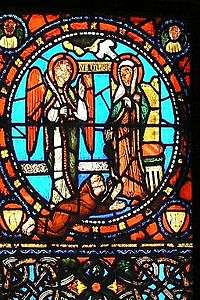 12th century stained glass from Basilica of Saint-Denis
12th century stained glass from Basilica of Saint-Denis
Early French Gothic cathedrals
Sens Cathedral
Following the model of Saint-Denis, Sens Cathedral became the first complete Gothic cathedral. It was constructed between 1135 and 1164. It used the new six-part rib vault in the nave, giving the church exceptional width and height. Because the six-part vaults distributed the weight unevenly, the vaults were supported by alternating massive square piers and more slender round columns. [7][8][9] It had a wide impact on the Gothic style not only in France, but also in England, because its master builder, William of Sens, was invited to England and introduced Early Gothic features to the reconstructed nave of Canterbury Cathedral.
 Facade of Sens Cathedral (1135-64)
Facade of Sens Cathedral (1135-64).jpg) Elevation of Sens Cathedral, showing the three levels (arcades, Triforium, and clerestory at the top)
Elevation of Sens Cathedral, showing the three levels (arcades, Triforium, and clerestory at the top)
Senlis Cathedral
Senlis Cathedral was built between 1153 and 1191. Its length was limited by modest budget and by the placement of the building against the city wall. Like Sens cathedral, it was composed of a nave without a transept, flanked by a single collateral. The choir, like Saint-Denis, was surrounded by radiating chapels. The elevation had three levels, including large tribunes. Like Sens, Senlis Cathedral had alternating strong and weak piers to receive the uneven thrust from the six-part rib vaults. The church underwent considerable rebuilding in the 13th and 16th century, including a new tower and new interior decorations. Many of the early Gothic features are overladen with Flamboyant and later decoration.[10].
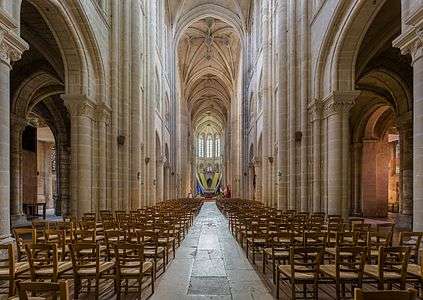 Nave of Senlis Cathedral (1153–91)
Nave of Senlis Cathedral (1153–91)%2C_cath%C3%A9drale_Notre-Dame%2C_chapelle_Sainte-Genevi%C3%A8ve%2C_chapiteaux_au_nord_du_doubleau_interm%C3%A9diaire_1.jpg) Sculpted capitals of the piers, Chapel of Sainte-Genevieve, Senlis Cathedral
Sculpted capitals of the piers, Chapel of Sainte-Genevieve, Senlis Cathedral
Noyon Cathedral
Noyon Cathedral, begun between 1150 and 1155, was the first of a series of famous Cathedrals to appear in Picardy, the prosperous region north of Paris. The city an important connection with French history, as the coronation site of Charlamagne and of the early French King Hugh Capet. The new cathedral still had many Romanesque features, including prominent transepts with rounded ends and deep galleries, but it introduced several Gothic innovations, including the fourth level, the triforium a narrow passageway between the ground-level gallery, the tribunes, and the top level clerestory, Noyon also used massive compound piers alternating with round columns, necessary because of the uneven weight distribution from the six-part vaults.[5] The east end has five radiating chapels and three levels of windows, creating a created a dramatic flood of light into the nave. [11]
- Facade of Noyon Cathedral (begun 1150-55)
%2C_cath%C3%A9drale_Notre-Dame%2C_bas-c%C3%B4t%C3%A9_nord%2C_vue_diagonale_vers_le_sud-ouest_par_la_6e_et_5e_grande_arcade.jpg) The alternating piers and columns of the grand arcade, which support the vaults
The alternating piers and columns of the grand arcade, which support the vaults
Laon Cathedral
Laon Cathedral (begun c. 1190), was built at the same time as Notre Dame de Paris, and was an equally large project, but had a strikingly different appearance. Laon was built upon a hilltop one hundred meters high, making it visible from a great distance. The hilltop imposed a special burden for the builders; all the stones had to be carried to the top of the hill in carts drawn by oxen. The oxen who did the work were honored by statues on the tower of the finished cathedral. [12]
Laon was also unusual because of its five towers; two on the west front, two on the transepts, and an octagonal lantern on crossing. Laon, like most early Gothic cathedrals, had four interior levels. Laon also had alternating octagonal and squar piers supporting the nave, but these rested upon massive pillars made of dreamlike sections of stone, giving it greater harmony and a greater sensation of length.[13] The new cathedral was unusual in form; The apse on the east was flat, not rounded, and The choir was exceptionally long, nearly as long as the nave.[14]. Another striking feature of Laon Cathedral were the three great rose windows, one on the west facade and two on the transepts. (Only the west and north windows still remain). Another unusual feature at Laon is lantern tower at the transept crossing, most likely inspired by the Norman Gothic abbey churches in Caen. {Sfn|Mignon (2015)|pages=16-17}}
 Laon Cathedral (1150s-1230)
Laon Cathedral (1150s-1230)- Nave of Laon Cathedral, looking east
 The buttresses of the rounded chevet of Laon Cathedral
The buttresses of the rounded chevet of Laon Cathedral
Notre Dame de Paris
Notre Dame de Paris was the largest of the Early Gothic cathedrals, and marked the summit of the Early Gothic in France. It was begun in 1163 by the Bishop Maurice de Sully with the intention of surpassing all other existing churches in Europe. The new cathedral was 122 meters long and 35 meters high, eleven meters higher than Laon Cathedral, the previous tallest church. It featured a central nave flanked by double collaterals, and a choir surrounded by a double ambulatory, without radiating chapels. (The current chapels were added between the buttresses in the 14th century). [15]
The builders covered the interior of the Cathedral with six-part vaults, but unlike Sens and other the earlier cathedrals they did not use alternating piers and columns to support them. The vaults were supported instead by bundles of three uninterrupted slender columns which were received by rows massive pillars with capitals decorated with classical decoration. This gave the nave greater harmony.
The original elevation of Notre Dame had four levels, This was reduced to three in the 13th century, when it was decided that the interior was too dark, but it was returned to four levels around the transept during the restoration by Viollet-le-Duc. [15]
The flying buttress made its first appearance in Paris in the early 13th century, either at Notre Dame, or perhaps earlier in the Abbey of Saint-Germain-des-Pres. The buttresses, in the form of half-arches, reached from the heavy buttresses outside the nave, over the top of the tribunes, and pressed directly against the upper walls of the nave, countering the outward thrust from the vaults. This made possible the installation of larger windows in the upper walls of the nave the buttresses. [15]
 West front of Notre Dame de Paris (begun 1163)
West front of Notre Dame de Paris (begun 1163)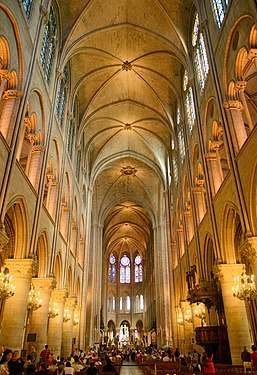 The nave of Notre Dame looking to the east, showing the four levels and the six-part rib vaults
The nave of Notre Dame looking to the east, showing the four levels and the six-part rib vaults The flying buttresses of Notre Dame as they appeared in about 1220-30 (drawn by Eugène Viollet-le-Duc)
The flying buttresses of Notre Dame as they appeared in about 1220-30 (drawn by Eugène Viollet-le-Duc)
Early Gothic in Normandy
Experiments with Gothic features were also underway in Normandy in the early 12th century. In 1098 Lessay Abbey was given an early version of the rib vault in the choir. [16] The church of Saint-Pierre de Lisieux, built in the 1190s, was another very early example. Other Experments with Gothic rib vaults and other features took place in Caen, in the churches of the two large royal abbeys churches, the Abbey of Saint-Étienne, Caen and the Abbey of Sainte-Trinité, Caen, But they remained essentially Norman Romanesque churches.[17]
Rouen Cathedral had notable early Gothic features, added when the interior was reconstructed from Romanesque to Gothic by archbishop Gautier de Coutances beginning in 1185. The new Gothic nave was given four levels, while the later choir had the newly fashionable three. [17]
Early Gothic in England
Early experiments - Durham Cathedral
English architects had experimented with early Gothic features. At Durham Cathedral, a Romanesque church, a traverse of the nave and lower aisle was made with an early variation a rib vault, a ribbed groin vault, or meeting place of two barrel vaults, with stone ribs. The ribbed groin vaults were installed in 1093-96, and were the first of their kind in Europe. As the work continued, the builders experimented with an even bolder variation, using pointed instead of rounded arches, to spread the weight outwards. The new pointed rib vaults were installed over the south transept and nave beginning in 1130. These were probably the first pointed arch rib vaults in Europe. The new vaults were not entirely successful; the thin panels between the ribs were made of plastered rubble, and were too heavy and cracked, and in 1235 they had to be replaced. Newer and lighter versions of the rib vault, using small pieces of cut stone in the panels, rather than plastered rubble, were developed in Normandy and the Ile-de-France. Pointed Rib vaults did not fully take hold in England until the second half of the 12th century. [18]
Canterbury Cathedral
One of the first major buildings in England to use the new style was Canterbury Cathedral. A fire destroyed the mainly Romanesque choir in September 1174, and leading architects from England and France were invited to offer plans for its reconstruction. The winner of this competition was a French master builder, William of Sens, who had been involved in the construction of Sens Cathedral, the first complete Gothic cathedral in France. [19]
Many limitations were put upon William of Sens by the monks who ran the Cathedral. He was not allowed to replace entirely the original Norman church, and had to fit his his new structure on the old crypt and within the surviving outer Norman walls. Nonetheless, he achieved a strikingly original sculpture, showing elements inspired by Notre-Dame de Paris and Laon Cathedral. Following the French model, he used six-part rib vaults, pointed arches, supporting columns with carved acanthus leaf decoration, pointed arches, and a semi-circular ambulatory. However, other elements were purely English, such as the use of dark purbeck marble to create decorative contrasts with the pale stone brought from Normandy. The work was described a monk and chronicler, Gervase of Canterbury. Contrasting the old with the new choir. He wrote: "There, the arches and everything else was plain, or sculpted with an axe and not with a chisel. But here almost throughout is appropriate sculpture. There used to be no marble shafts, but here are innumerable ones. There in the circuit round the choir, the vaults were plain, but here they are arch-ribbed and have key-stones." [20]
William of Sens fell from a scaffolding in 1178 and was seriously injured, and returned to France, where he died, [21] and his work was continued by an English architect, William the Englishman, who constructed the Trinity Chapel in the apse and the Corona in the east end, which were monuments to Thomas Becket, who had been murdered in the Cathedral. The new structure had many French features, such as the doubled columns in the Trinity chapel, and piers replaced by Purbeck-marble wall shafts. But it also retained many specifically English features, such as a great variety in the level and placement of the spaces; the Trinity chapel, for example is sixteen steps above the Choir). It also retaining rather than eliminated the transepts - Canterbury had two. Early English Gothic put an emphasis on great length; Canterbury was doubled in length between 1096 and 1130. [20]
One reason for the differences between French and English Gothic was that French Benedictine abbey-churches usually put different functions into separate buildings, while in England they were usually combined in the same structure. Similar complicated multifunctional designs were found not only in Canterbury, but in the abbey-churches of Bath, Canterbury, Conventry, Durham, Ely, Norwich, Rochester, Winchester and Worcester.[22]
.jpg) Choir of Canterbury Cathedral rebuilt by William of Sens (1174–1184)
Choir of Canterbury Cathedral rebuilt by William of Sens (1174–1184) The windows and vaults of Trinity Chapel, Canterbury Cathedral
The windows and vaults of Trinity Chapel, Canterbury Cathedral
The Cistercian Abbeys
Another notable form of early English Gothic architecture was that of the Cistercian monasteries. The Cistercian order had been formed in 1098 as a reaction against the opulence and ornament of the Benedictine order and its monasteries. The architecture of the Cisterians was based upon simplicity and functionality. All decoration was forbidden. The Cistercian monasteries were in remote locations, far from the cities. They were closed in 1539 during the reign of Henry VIII, and now are picturesque ruins. Examples include Kirkstall Abbey (c. 1152); Roche Abbey (c. 1172), and [[Fountains Abbey) (c. 1132) all in Yorkshire.
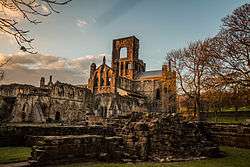 Kirkstall Abbey (c. 1152)
Kirkstall Abbey (c. 1152)- Roche Abbey (c. 1172)
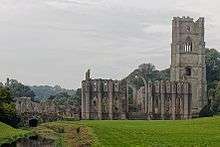 Fountains Abbey (c. 1132)
Fountains Abbey (c. 1132)
Wells Cathedral
Wells Cathedral, (built between 1185 1200 and modified until 1240) is another leading example of the early English style. It borrowed some aspects, such as its elevation, from the French style, but gave precedence to strong horizontals, such as the triforium, rather than the dominant vertical elements, such as wall shafts, of the French style. The piers were composed of as many as twenty-four shafts, adding another unusual decorative effect.[23] The north porch, built in 1210-15, and especially the west front (1220-1240) had a particularly novel decorative effect. The screen facade of the west front is filled with nearly four hundred carved and painted stone figure, and is made more impressive by two flanking towers, not attached to the body of the church. This arrangement was adapted by other English cathedrals, including Salisbury Cathedral and Exeter Cathedral.[23]
Lincoln Cathedral
Lincoln Cathedral (rebuilt from the Norman style beginning in 1192) is another major example of early English Gothic. The master-builder, Geoffrey de Noier, was French, but he constructed a church with distinct non-French features; double transepts, an elongated nave, complexity of interior space, and a more lavish use of decorative features.[23] St. Hugh's Choir, named after the French-born monk St. Hugh of Lincoln, was a good example. The choir was covered with a rib vault in which most of the ribs had a purely decorative role. In addition to the functional ribs, it featured extra ribs called tiercerons, which did not lead to the central point of the vault, but to a point along the ridge rib on the crown of the vault. They were put together in lavish designs, which gave the resulting ceiling the nickname "The crazy vault." [23]
Another distinctive English element introduced at Lincoln was the blind arcading in the chapel. Two layers of arcades with pointed arches are attached to the walls, giving a theatrical effect of three dimensions. This element is enhanced by the use of different color stone for the thin columns; ribs of white limestone for the lower columns and black purbeck marble for the upper portions. [23]
See Also
References
- Renault and Lazé (2006), p. 36.
- Renault and Lazé (2006), p. 33
- Watkin (1986), p. 126-127.
- Watkin (1986), p. 127.
- Watkin (1986), p. 128.
- Encylopaedia Britannica on-line, "Western architecture - Early Gothic" (retrieved 24 June, 2020)
- Mignon (2015) & pp. 10-11.
- Le Guide du Patrimoine de France (2002) pg. 53
- Renault and Lazé (2006), pp. 33–35
- Mignon, Olivier, ‘’Architecture des Cathedrales Gothique’’ (2015), pg. 16-17
- Mignon, Olivier, ‘’Architecture des Cathedrales Gothique’’ (2015), pg. 14
- Mignon (2015), pp. 16-17.
- Watkin (1986), p. 129.
- Mignon (2015), p. 67.
- Mignon (2015), pp. 18-19.
- Encyclopédie Larousse on-line, "Le Premier Art Gothique" (retrieved May 3, 2020
- Mignon (2015), p. 30-31.
- Watkin 1986, p. 108-109.
- Watkin (1986), p. 143.
- Watkin (1986), p. 143-144.
- "As work began on the vault of the eastern part of the choir, William was incapacitated by a fall from a scaffold. He probably continued to direct the work from his sickbed, but this was impractical, and so he gave up and returned to France, where he died." Encyclopaedia Britannica on-line, retrieved April 21, 2020
- Watkin (1986), p. 144-145.
- Watkin (1986, p. 145.
Bibliography
- Ducher, Robert, Caractéristique des Styles, (1988), Flammarion, Paris (in French); ISBN 2-08-011539-1
- Mignon, Olivier (2017). Architecture du Patrimoine Française - Abbayes, Églises, Cathédrales et Châteaux (in French). Éditions Ouest-France. ISBN 978-27373-7611-5.
- Renault, Christophe and Lazé, Christophe, Les Styles de l'architecture et du mobilier, (2006), Gisserot, (in French); ISBN 9-782877-474658
- Rivière, Rémi; Lavoye, Agnès (2007). La Tour Jean sans Peur, Association des Amis de la tour Jean sans Peur. ISBN 978-2-95164-940-8
- Texier, Simon, (2012), Paris Panorama de l'architecture de l'Antiquité à nos jours, Parigramme, Paris (in French), ISBN 978-2-84096-667-8
- Watkin, David (1986). A History of Western Architecture. Barrie and Jenkins. ISBN 0-7126-1279-3.CS1 maint: ref=harv (link)
- Wenzler, Claude (2018), Cathédales Cothiques - un Défi Médiéval, Éditions Ouest-France, Rennes (in French) ISBN 978-2-7373-7712-9
- Le Guide du Patrimoine en France (2002), Éditions du Patrimoine, Centre des Monuments Nationaux (in French) ISBN 978-2-85822-760-0